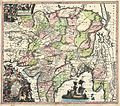Soubor:1740 Seutter Map of India, Pakistan, Tibet and Afghanistan - Geographicus - IndiaMogolis-seutter-1740.jpg

Velikost tohoto náhledu: 679 × 600 pixelů. Jiná rozlišení: 272 × 240 pixelů | 543 × 480 pixelů | 869 × 768 pixelů | 1 159 × 1 024 pixelů | 2 318 × 2 048 pixelů | 5 000 × 4 418 pixelů.
Původní soubor (5 000 × 4 418 pixelů, velikost souboru: 8,42 MB, MIME typ: image/jpeg)
Historie souboru
Kliknutím na datum a čas se zobrazí tehdejší verze souboru.
| Datum a čas | Náhled | Rozměry | Uživatel | Komentář | |
|---|---|---|---|---|---|
| současná | 22. 3. 2011, 22:49 |  | 5 000 × 4 418 (8,42 MB) | BotMultichillT | {{subst:User:Multichill/Geographicus |link=http://www.geographicus.com/P/AntiqueMap/IndiaMogolis-seutter-1740 |product_name=1740 Seutter Map of India, Pakistan, Tibet and Afghanistan |map_title=Imperii Magni Mogolis sive Indici Padschach, juxta recentiiss |
Využití souboru
Tento soubor používá následující stránka:
Globální využití souboru
Tento soubor využívají následující wiki:
- Využití na ar.wikipedia.org
- Využití na beta.wikiversity.org
- Využití na bn.wikipedia.org
- Využití na ca.wikipedia.org
- Využití na el.wikipedia.org
- Využití na en.wikipedia.org
- Využití na eo.wikipedia.org
- Využití na es.wikipedia.org
- Využití na incubator.wikimedia.org
- Využití na it.wikipedia.org
- Využití na pnb.wikipedia.org
- Využití na ru.wikipedia.org
- Využití na te.wikipedia.org
- Využití na ur.wikipedia.org
- Využití na www.wikidata.org



